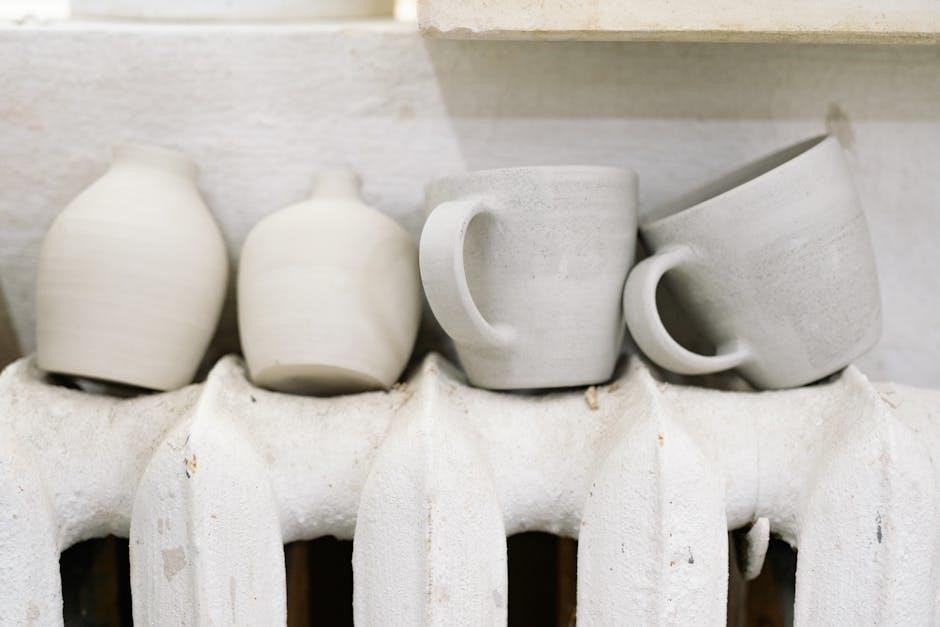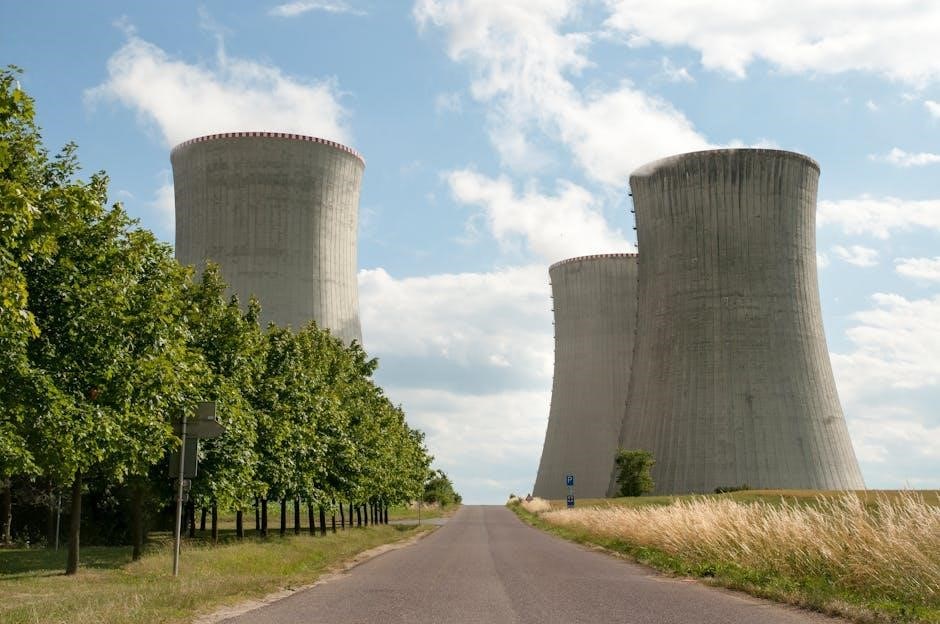Heating and Cooling Curves: An Overview
Heating and cooling curves are graphical representations. They plot a substance’s temperature against heat. Heating curves start with a solid‚ adding heat. Cooling curves begin with a gas‚ removing heat. These curves have segments.

Understanding Heating Curves
Heating curves graphically show the correlation between heat input and temperature. They show temperature changes as a substance heats up. Key features are plateaus at phase changes. These illustrate endothermic processes absorbing heat as it’s added.
Definition of a Heating Curve
A heating curve is a graphical representation showing how a material’s temperature changes over time as heat is added. It illustrates the relationship between the heat absorbed by a substance and its corresponding temperature increase. This curve provides a visual depiction of the phase transitions a substance undergoes as it is heated‚ revealing valuable information about its thermal properties.
Specifically‚ a heating curve plots temperature on the y-axis and heat added (or time‚ assuming a constant heating rate) on the x-axis. The resulting graph showcases distinct regions‚ including sloped lines indicating temperature increases within a specific phase (solid‚ liquid‚ or gas) and horizontal plateaus representing phase changes‚ where the temperature remains constant despite continuous heat input. Analyzing these features allows for determining melting and boiling points.
Key Features of a Heating Curve
Heating curves possess key features that provide insights into a substance’s behavior upon heating. The initial upward sloping segment represents the solid phase‚ where temperature rises as heat is absorbed. A plateau then indicates the melting point‚ during which the substance transitions from solid to liquid at a constant temperature due to the energy input breaking intermolecular forces rather than increasing kinetic energy.
Following melting‚ another upward slope signifies the liquid phase’s temperature increase. Another plateau appears at the boiling point‚ showcasing liquid-to-gas phase transition. Finally‚ the last upward segment demonstrates temperature rising in the gaseous phase as more heat is added. These distinct regions are fundamental in understanding phase transitions.
Understanding Cooling Curves
Cooling curves illustrate temperature changes as a substance cools. They mirror heating curves. They show phase changes from gas to liquid‚ then liquid to solid. These curves help analyze material behavior during cooling processes.
Definition of a Cooling Curve
A cooling curve is a graph showing the change in temperature of a substance over time as it loses heat to its surroundings. It’s essentially the inverse of a heating curve. Instead of adding heat‚ we’re removing it‚ observing how the temperature decreases as the substance transitions through different phases.
The cooling curve visually represents the relationship between temperature and time (or energy loss) during the cooling process. It’s a valuable tool for understanding the thermal behavior of materials and identifying key phase transition points.
The gradient of the cooling curve is related to the heat capacity‚ the thermal conductivity of the substance‚ and the external temperature.
Studying cooling curve is always natural because temperatures just approach each other as the energy gets redistributed.
Key Features of a Cooling Curve
Cooling curves‚ like heating curves‚ exhibit distinct features. Starting at a higher temperature (typically in the gas phase)‚ the curve shows a decrease in temperature as heat is removed. A key feature is the presence of plateaus. These plateaus indicate phase changes‚ such as condensation (gas to liquid) or freezing (liquid to solid).
During these plateaus‚ the temperature remains constant even though heat is being removed‚ because the energy is used to change the state of matter rather than decreasing the kinetic energy of the molecules. The steepness of the curve between plateaus reflects the rate of temperature change within a single phase. The cooling rate is the slope of the cooling curve at any point.

Phase Transitions and Plateaus
When a substance is heated or cooled‚ it reaches a temperature corresponding to phase transitions. Further heat gain/loss diminishes or enhances intermolecular attractions. The temperature remains constant while a substance changes state‚ resulting in plateaus.
Explanation of Plateaus on Heating/Cooling Curves
Plateaus on heating or cooling curves represent phase changes. During these plateaus‚ added heat doesn’t increase temperature‚ but breaks intermolecular bonds. For example‚ ice melts to water at 0°C‚ with temperature constant until all ice melts. Then‚ the temperature rises again.
Similarly‚ water boils to steam at 100°C‚ remaining at that temperature until all water is vaporized. These plateaus indicate energy is used for phase transition‚ not kinetic energy increase.
Cooling curves exhibit similar plateaus during condensation and freezing. The length of the plateau depends on the amount of substance and the latent heat involved in the phase change.
Therefore‚ plateaus signify phase changes where temperature remains constant as energy facilitates the transition between states.
Relationship Between Latent Heat and Phase Changes
Latent heat is crucial for understanding phase transitions on heating and cooling curves. It represents the energy absorbed or released during phase changes‚ without changing temperature. This energy overcomes intermolecular forces‚ enabling transitions between solid‚ liquid‚ and gas phases.
During melting‚ latent heat of fusion is absorbed to convert a solid to a liquid. Conversely‚ freezing releases the same amount of heat. Similarly‚ vaporization requires latent heat of vaporization‚ while condensation releases it.
The plateaus on heating and cooling curves directly correlate with latent heat. Longer plateaus indicate more energy needed for the phase change. Different substances have varying latent heats‚ influencing plateau lengths.
Thus‚ latent heat dictates the energy required for phase transitions‚ evident in the plateaus of heating and cooling curves.

Factors Affecting the Shape of Heating and Cooling Curves
Several factors influence the shape of heating and cooling curves. These include the nature of the substance and the heating or cooling rate. Understanding these factors helps analyze and interpret these curves accurately.
The Nature of the Substance
The identity of the substance significantly impacts the shape of its heating and cooling curves. Different substances have different melting and boiling points. These unique properties dictate the temperatures at which phase transitions occur‚ influencing the horizontal plateaus on the curves. For instance‚ iron’s heating curve differs greatly from water’s due to their distinct melting (1538°C for iron) and boiling points (2861°C for iron).
The strength of intermolecular forces also plays a crucial role. Substances with strong intermolecular forces require more energy to overcome these attractions during phase changes. This results in longer plateaus on the curves‚ representing the latent heat needed for the transition. Alloys‚ unlike pure substances‚ exhibit a melting point range‚ leading to a sloped‚ rather than horizontal‚ transition on the curve.
Heating/Cooling Rate
The heating or cooling rate significantly affects the appearance of heating and cooling curves. A faster heating rate means energy is supplied more quickly. The temperature increases rapidly in the solid‚ liquid‚ and gas phases. However‚ the plateaus representing phase changes might appear less distinct.
Conversely‚ a slower heating rate allows for a more gradual temperature increase‚ resulting in well-defined plateaus. The system has more time to reach thermal equilibrium during phase transitions. Similar principles apply to cooling curves. A rapid cooling rate leads to quick temperature drops and potentially less distinct plateaus. A slow cooling rate allows for a more gradual decrease‚ creating clearer phase transition plateaus‚ and better matching theoretical curves. In essence‚ the rate influences the curve’s sharpness.

Applications of Heating and Cooling Curves
Heating and cooling curves are useful. They determine melting and boiling points. They also analyze material phase changes. By analyzing these curves‚ we can learn more about latent heat and thermal conductivity.
Determining Melting and Boiling Points
Heating and cooling curves are invaluable tools. One key application is in determining the melting and boiling points of substances. These points are crucial characteristics. They help identify materials and understand their behavior under different temperatures. On a heating curve‚ the melting point is represented by the temperature at which the first plateau occurs.
This plateau signifies the phase change from solid to liquid. Similarly‚ the boiling point is identified by the temperature at the second plateau. This plateau indicates the phase change from liquid to gas. By accurately reading these plateaus‚ we can precisely determine these transition temperatures.
Cooling curves offer the same information. The freezing point is the first plateau‚ and the condensation point is the second. Analyzing these curves lets us understand how a substance behaves as heat is added or removed.
Analyzing Phase Changes of Materials
Heating and cooling curves are essential for analyzing phase changes in materials. These curves provide a visual representation of how a substance transitions between solid‚ liquid‚ and gas phases. By examining the shape and characteristics of these curves‚ scientists can gain valuable insights into the thermal behavior of various materials.
The plateaus on the curves indicate phase transitions. The length of these plateaus is directly related to the amount of energy required for the phase change‚ known as latent heat. Different materials exhibit unique heating and cooling curves. This is due to variations in their intermolecular forces and heat capacities.
Analyzing these variations allows researchers to understand the properties of materials; This helps them develop new materials with desired thermal characteristics. Furthermore‚ studying these curves can reveal information about the purity of a substance. Impurities can affect the shape and temperatures of the phase transitions.

Leave a Reply